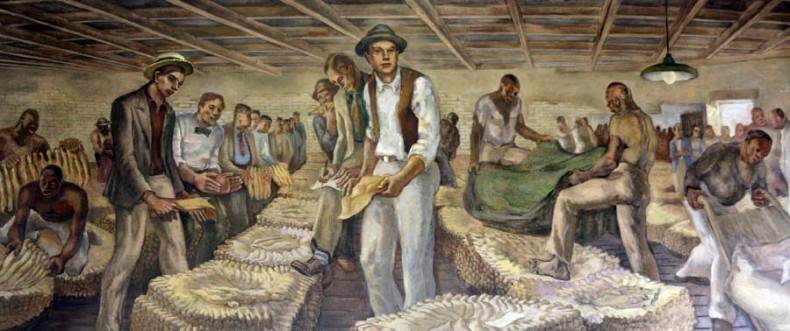Post Office Art
Depression-era artwork in post offices expressed local history and hope
By Marilyn JonesYou can buy stamps and mail parcels at your local post office. The lobbies usually are bustling places where people in a hurry to conduct their business might not notice the wall murals and other artwork, and probably don't realize it might have been executed by an American master if the building dates back to the 1930s or early 40s.
In Lincolnton, for example, there is a mural above the postmaster's office door depicting men thrashing wheat entitled, appropriately, "Threshing Grain." The mural was painted in 1938 by Richard Jansen.
In Louisburg, Richard Kenah painted "Tobacco Auction" in 1938. He also painted post office murals in Bridgeport, Ohio, and Bluefield, W. Va.
The art, and construction of the post offices where the art is displayed, were part of Franklin D. Roosevelt's promise when he accepted the Democratic nomination for president in 1932: "I pledge myself to a new deal for the American people. This is more than a political campaign. It is a call to arms."
George Biddle, a Philadelphia artist, first suggested the idea of commissioning artists to decorate federal buildings. In 1933, a pilot program was created as a New Deal initiative. Because of the pilot's success, project administrators created a unit within the Treasury Department, the Section of Fine Art, which became known simply as "the Section."
Artists were not chosen on the basis of need, but through anonymous competitions. Some were well established with national reputations, such as Jackson Pollock and Mark Rothko. Others were young unknowns whose commission provided them with their first public exposure.
The artists were expected to follow an adaptable format — the art was to reflect the town's heritage. To make sure that happened, the artist had to meet with the postmaster and local residents. The Post Office Department's approval then had to be obtained, and finally the plans were submitted for final approval by the Section. The art was meant to provide the average American with a public outlet to view professional art.
From 1934 to 1943, more than 1,300 murals and 300 sculptures were commissioned nationwide. One percent of the funds appropriated for a building project was set aside for these "embellishments."
When touring the state to view New Deal artwork, you'll find positive images — the hard realities of American life during the Depression are not illustrated on post office walls or building exteriors. The artwork offers a snapshot not only of history but also of hope.
Every piece of post office art has its own story: a window into the artistic tastes of the 1930s and '40s, what subject matter residents felt best reflected their community and the artists, their successes before and after the artwork was created for the post office.
A few of the art pieces have disappeared over time, while others are in need of repair. In some cases these masterpieces have been moved from their original locations or the buildings sold.
These treasures are located throughout the state. If you haven't yet visited any of the Depression-era postal facilities, take the time — it's everyone's heritage.
About the Author
Marilyn Jones is a freelance writer in Texas with an expertise in U.S. Postal Service issues.-
Share this story:




Comments (1)
Bonnie Rusinko |
April 11, 2018 |
reply